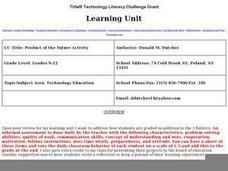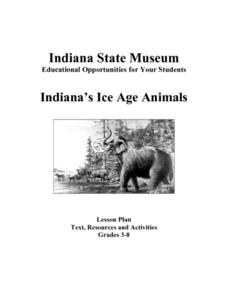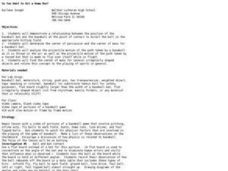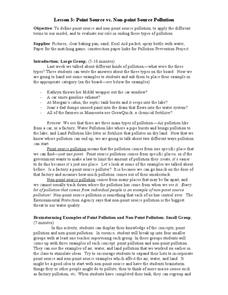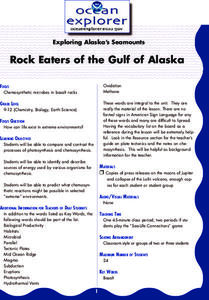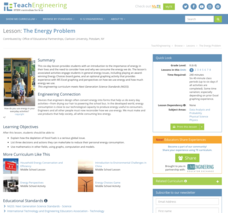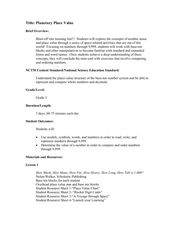Curated OER
Product of the Future Activity
Students predict what computers, games, or products be like in 2030. They think about and design futuristic products.
Curated OER
West Virginia Quarter Reverse: Over, Under, In, and Out
Students examine the images on the West Virginia quarter reverse. Using the quarter design as a model, the discover the meaning of directional terms. They play a game where they have to listen to and follow directions and complete a...
Curated OER
Investigating Sources-Artifacts
Students discuss artifacts. In this social science lesson, students realize that artifacts can help one in determining about the person the artifacts belonged to. Students will be put into small groups and will look at objects from a box...
Curated OER
Upcycled Garment or Art Work
Students explain the importance of recycling waste products. In this art lesson, students research different upcycled fashion designs and accessories. They design their own product and present it in class.
Curated OER
Who says I can't be Sherlock Holmes?
Young scholars create a "crime scene" in their classroom and have to tell what's out of place. The class is given a set of cards that are all face down and have to play concentration. If they get a matched pair, they get both cards....
Curated OER
I Wonder What An Important Observation Is...
Students discover the importance of descriptions and detail in their writing. They write in their scientific journals and are evaluated by the teacher. They write a descriptive piece and evaluate their own writing as well.
Curated OER
So You Want to Hit a Home Run?
Young scholars determine the center of percussion and the center of mass for a baseball bat. In this projective motion lesson students demonstrate the relationship between the position of the baseball bat and when its in the...
Curated OER
Point Source vs. Non-point Source Pollution
Students define and differentiate between point source and non-point source pollution. Students discuss various types of pollution including air, water and land pollution, analyze demonstrations and complete a worksheet.
Curated OER
Spawn!
Students explain that the ability of certain reef fishes to have a successful spawning is dependent on numerous environmental conditions. They list some of the factors needed by reef fishes in the South Atlantic Bight to have a
Curated OER
Rockin' and Rollin'
Seventh graders, in groups, describe the three major types of rocks through either a song, skit, poem, etc. They present their work to the class during a "rock concert."
Curated OER
Adaptable Mandibles
Students define adaptation and highlight example of adaptation in birds and other animals. They study feeding techniques of seabirds and investigate the effect that trash has on wildlife.
Curated OER
Introduction to Macroinvertebrates
Third graders investigate the world of macroinvertebrates and identify the environmental stressors that threaten their existence. Outdoors, they role-play as stressors and invertebrates, with the intolerant species doing pushups, spins,...
Curated OER
Rock Eaters of the Gulf of Alaska
High schoolers compare and contrast the processes of photosynthesis and chemosynthesis. They identify and describe sources of energy used by various organisms for chemosynthesis.
Curated OER
The Wind-Up and the Pitch
Students consider how sound affects one's experience at a ballpark and the ways that the acoustics at a baseball stadium might be improved. Students then recommend their own designs for a "soundly built" baseball stadium.
Curated OER
Skagway School Hatchery Involvement
Tenth graders are given the opportunity to use what they are learning in their other academic courses, as well as in the hatchery class.
Curated OER
Perfection on Ice!: Math, Geometry, Fibonacci Numbers, Olympics
Students use the human body as a foundation for gaining practice in measuring angles and calculating ratios and proportions.
Curated OER
The Animals of Julie of the Wolves
Learners explore Arctic animal life through use of electronic resources. They discover facts about various animals that share that ecosystem with wolves.
Curated OER
Floristic Relay
Fifth graders identify the role succession plays in the adaptation of our environment. Students identify pioneer and climax species and order habitats in succession. They recognize that different characteristics of species make them...
Curated OER
Think Green
Pupils experience and practice compositing and recycling through hands-on-activities. They distinguish between which items from their trash can be recycled, composted and reused. The process for making recycled paper is also covered in...
Teach Engineering
The Energy Problem
Think you can solve the energy problem? You'll first need to know about current energy use. Analyzing a set of circle graphs lets scholars see where energy consumption is the greatest, both by sector and by household use. They develop a...
Curated OER
Classroom Supplies
Challenge young mathematicians to buy classroom supplies by staying within the means of a $1,000 budget. The mathematical activity provides learners with the opportunity to decide what items from the supply list would benefit a class of...
Curated OER
Money Makes the Fair-Go-Round
Learners explore the value of money. In this money lesson plan, students investigating combining amounts of money and making change. Learners count sets of money and make fair trades. Resources are provided.
Curated OER
Planetary Place Value
Third graders explore place value to the ten thousands place. This incredibly thorough, 24-page lesson has learners construct, order, and compare numbers to 9,999. This three-day lesson includes reteaching and extension activities...
National Security Agency
A Balancing Act: Solving Multi-Step Equations
Wow! Put on that thinking cap and solve multi-step equations. To solve equations, learners review the use of the distributive property and combining like terms. This three-day lesson comes with about 20 pages of worksheets, warm-ups,...
